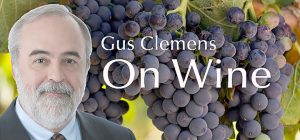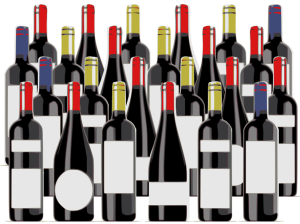Wine bottles come in various shapes, sizes, weights, and colors of glass. A quick tour.
Bottle shapes:
• Tall, slender. Wines from Germany’s Mosel and France’s Alsace. Green, brown, and blue glass historically marked regional differences.
• Tall, curvy, often distinctive. Once exclusive for rosés from the Côtes de Provence. Now can be a distinctive bottle for rosé anywhere.
• Burgundy. Curved sides, gradually sloped necks, wide main body. Usually associated with pinot noir and chardonnay, now is used for other reds and oaked whites.
• Bordeaux. Sharply sloping shoulders; main body is not as fat as Burgundy bottle. Associated with cabernet sauvignon, merlot, other Bordeaux varieties and blends. Some think the shape is meant to handle sediment when decanting.
• Sparkling. Intended for Champaign, cava, other sparkling wines. Glass is noticeably thicker, punt deeper. Constructed to protect the wine during production moments like disgorgement and riddling. A “mushroom” cork and a twisted wire closure keep the bubbly’s pressure intact, as does the heavier glass. The pressure inside is 60-90 psi; pressure in the tire of a family car is 32-35 psi.
• Fiasco. Short, rounded wide base, covered with a straw basket. Once the go-to bottle for Chianti.
• Unique bottles. Any shape the winery can dream up and bottle maker produce, from stubby to square to you-name-it. No specific wine. Designed to stand out on a wine shop shelf.
Bottle volumes:
• Piccolo. Holds 187 milliliters (ml), a little more then one standard serving.
• Demi. Half-bottle, holds 375 ml.
• Standard. Holds 750 ml; five standard pours.
• Magnum. Twice as large as standard bottle; holds 1.5 liters. Keeps sparkling wine fresh longer; slower aging for still wines because there is less oxidation.
• Jeroboam. Twice as large as a magnum; holds 3 liters—five times as much as a standard bottle. Ideal for a party for wine drinkers.
Tasting notes:
• Chateau Domecq White Wine, Valle de Guadalupe, Mexico 2021: If you have not experienced a wine from Mexico, this is excellent place to start. Mostly chardonnay with dash of viognier. $14-16
• Duchman Family Winery Roussanne, Oswald Vineyard 2020: Rich, complex with distinct fruitiness enveloped by creamy mouthfeel and crisp acidity. Made in Texas using Texas grapes. $26
• Wrath Wines Boekenoogen Vineyard Pinot Noir, Santa Lucia Highlands 2018: Enchanting interplay of black and red fruits. Significant whole cluster fermentation for sophistication and subtlety. $49-58
Last round: With the rise of self-driving vehicles, it is only a matter of time until there is a country song about a guy’s truck leaving him for another owner. Wine time.


